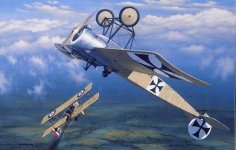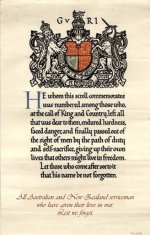I like this summing up. Would add that German air strategy was also effected by two other noteworthy influences on the Westfront. Their defensive tactics were in keeping with their being generally outnumbered, although they did shift forces in order to gain air superiority in certain sectors when offensives were planned. On the whole, being outnumbered, it was just smart to let their enemy come to them. This was also influenced by the wind conditions of the Westfront which saw the wind blowing from west (the Allied side) to East the vast majority of the time. This was a major factor when engaged because a damaged German aircraft could glide to their side of the lines whereas Allied aircraft had to fight the wind to regain their lines, something hard to do in a damaged aircraft. The wind also would push aircraft over the German lines and deeper into German territory while aircraft were fighting, something Allied airmen had to constantly be aware of as a fight progressed, both in terms of fuel consumption and possible damage. To take just two examples of the influence of the wind in air combat, both involving Manfred von Richthofen, one helped him, one got him killed. The first occurred in the famous dogfight between Richthofen and Lanoe Hawker. The dogfight lasted a long time, with the wind blowing the combattants deeper and deeper into German territory. At a given point, Hawker realised he had to get back to the British side of the lines as his fuel was running low. He was forced to break for home, allowing Richthofen to get on his tail. Richthofen shot him down. The second example occurred on a day when the wind was blowing from East to West (a relatively rare occurrence), and a disadvantage for the Germans. On this day, April 21, 1918, Richthofen engaged in an airfight that he became fixated on, and he suddenly found himself low over Allied lines, with the wind taking him deeper into Allied territory. He thus broke off his pursuit of the Allied aircraft, and turned for home. This low turn over Allied lines exposed him to a hail of ground fire which killed him.
The German defensive air strategy and their largely superior aircraft meshed with the Allied offensive strategy and their generally inferior aircraft (at least through mid-1917), resulted in large Allied losses. It was, however, French airmen who initially gained the advantage in the air war, before the Fokker's with their synchronized guns took control. The first true air-to-air victory was scored by a Russian, on August 26, 1914. He was in an unarmed plane and he rammed his opponent, thus killing the German and himself. The first air-to-air victory with a living victor was scored by France on October 26, 1914. The first 'Ace' of the air was the Frenchman Adolphe Pegoud, who from February, 1915, through July, 1915, scored 6 victories, before being KIA that August. It was another Frenchman, Roland Garros, along with aircraft designer Raymond Saulnier, who developed the first machine gun aircraft weapon to fire through the airscrew. This was done with a system of steel wedges attached to the propeller, directly in line of the MG barrel line of fire, that acted as deflectors for any bullet that might hit the prop. It wasn't a perfect system but it worked and it allowed Garros to terrorize German airmen as he shot down 3 German aircraft between April 1, 1915 and April 18, 1915. He then suffered engine failure on a later flight and came down in German territory and was captured. His secret weapon was exposed. The German High command commisioned Anthony Fokker to develope a similar weapon, which he did with a greatly improved advancement called synchronization, and the Fokker Scourge soon followed, but it was the early French flyers such as Pegoud, Garros, Navarre, Nungesser, and Guynemer who first controlled skies with their fighter tactics.
I believe the Germans did about as well as they could have in the skies of France, given their inferior numbers, their defensive startegy and tactics, and, as the war dragged on, their continuing decline in the raw materials needed to carry on a successful airwar, like oil, gas, and rubber. I just don't really see where being more aggressive would have helped, especially tactically, where their fighting methods brought them such success against the Allied airman. -- Al



